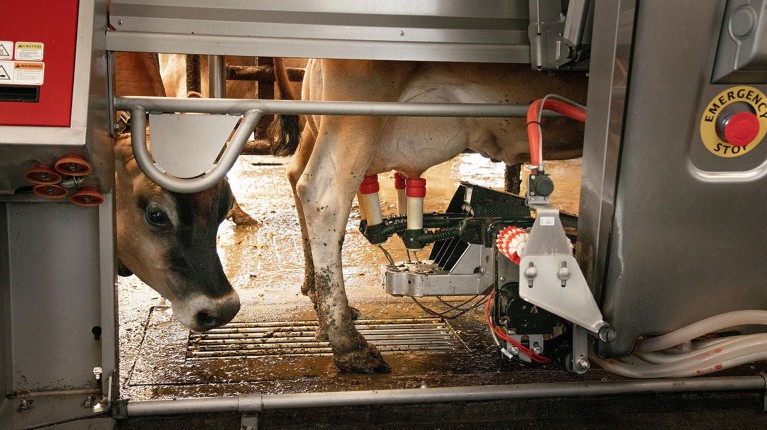[ad_1]

A cow is milked in Washington State.Credit: USDA Photo/Alamy
A strain of highly pathogenic avian influenza has been silently spreading in US cattle for months, according to preliminary analysis of genomic data. The outbreak is likely to have begun when the virus jumped from an infected bird into a cow, probably around late December or early January. This implies a protracted, undetected spread of the virus — suggesting that more cattle across the United States, and even in neighbouring regions, could have been infected with avian influenza than currently reported.
These conclusions are based on swift and summary analyses by researchers, following a dump of genomic data by the US Department of Agriculture (USDA) into a public repository earlier this week. But to scientists’ dismay, the publicly released data do not include critical information that would shed light on the outbreak’s origins and evolution. Researchers also express concern that the genomic data wasn’t released until almost four weeks after the outbreak was announced.
Speed is especially important for fast-spreading respiratory pathogens that have the potential to spark pandemics, says Tulio de Oliveira, a bioinformatician at Stellenbosch University in South Africa. The cattle outbreak is not expected to allow the virus to gain the ability to spread between people, but researchers say it is important to be vigilant.
“In an outbreak response, the faster you get data, the sooner you can act,” says Martha Nelson, a genomic epidemiologist at the National Center for Biotechnology Information (NCBI) in Bethesda, Maryland. Nelson adds that with every week that goes by, the window for controlling the outbreak narrows. “Whether we’re not too late, to me, that’s kind of the million dollar question.”
Single spillover
Federal officials announced on 25 March that a highly pathogenic bird-flu strain had been detected in dairy cows. The USDA has since confirmed infections with the strain, named H5N1, in 34 dairy herds in nine states. In late March and early April, the USDA posted a handful of viral sequences from cows sampled in Texas and a sequence from a human case, on the widely used repository GISAID.
On 21 April, the USDA posted more sequencing data on the Sequence Read Archive (SRA), a repository maintained by the NCBI. The latest upload included some 10 gigabytes of sequencing information from 239 animals, includings cows, chickens and cats, says Karthik Gangavarapu, a computational biologist at Scripps Research in La Jolla, who processed the raw data.
How countries are using genomics to help avoid a second coronavirus wave
Analysis of the genomes suggests that the cattle outbreak probably began with a single introduction from wild birds in December or early January. “It’s good news that there’s only been one jump that we can discern so far. But bad news, in many ways that it has been spreading for probably several months already,” says Michael Worobey, an evolutionary biologist at the University of Arizona in Tucson, who has analysed the genomes.
“This virus is clearly transmitting among cows in some way,” says Louise Moncla, an evolutionary virologist at the University of Pennsylvania in Philadelphia, who has studied the genomic data.
Nelson, who is analysing the data, says she was most surprised by the extent of the genetic diversity in the virus infecting cattle, which indicates that the virus has had months to evolve. Among the mutations are changes to a viral-protein section that scientists have linked to possible adaptation to spread in mammals, she says.
The data also show occasional jumps back from infected cows to birds and cats. “This is a multi-host outbreak,” says Nelson.
A single jump, many months ago, is “the most reliable conclusion you can make,” based on the available data, says Eric Bortz, a virologist at the University of Alaska Anchorage. But an important caveat is that it isn’t clear what percentage of infected cows the samples represent, he says.
Fill in the blank
That’s only one of many data gaps. Scientists lack information about each sample’s precise collection date and the state where it was collected. Such gaps are “very abnormal,” Nelson says.
The missing ‘metadata’ make it harder to answer many open questions, such as how the virus is transmitted between cows and herds, and make it tricky to pin down exactly when the virus jumped to cows. These insights could help to control further viral spread, and protect workers on cattle farms “who can least afford to be exposed,” says Worobey.
Worobey, Gangavarapu and their colleagues are now racing to analyse some metadata uncovered through online sleuthing by Florence Débarre, an evolutionary biologist at the French national research agency CNRS in Paris. Gangavarapu says dates and geographic information for 152 of the 239 samples have been extracted from a USDA presentation posted on YouTube on 26 April.
Real-time flu tracking
Researchers also want more swabbing of cattle and wild birds to gain more insights into the outbreak’s exact origin and to decipher another puzzle. The genomic data reveal that the viral genome sequenced from the infected person does not include some of the signature mutations observed in the cattle. “That is a mystery to everyone,” says Nelson.
One possibility is that the person was infected by a separate viral lineage, which infected cattle that have not been swabbed. Another less likely scenario, which can’t be ruled out, says Nelson, is that the person was infected directly from a wild bird. “It raises just a whole slew of questions about what black box of samples we are missing.”
Shilo Weir, a public affairs specialist at the USDA, says the agency decided to post the unanalysed sequence data on the SRA to make it public as soon as possible. Weir says the agency will “work as quickly as possible” to publish curated files on GISAID with relevant epidemiological information, and will continue to make raw data available on the SRA on a rolling basis.
[ad_2]
Source Article Link



